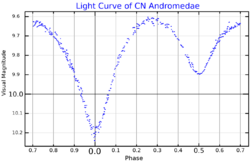Astronomy:CN Andromedae
| Observation data Equinox J2000.0]] (ICRS) | |
|---|---|
| Constellation | Andromeda |
| Right ascension | 00h 20m 30.54209s[2] |
| Declination | +40° 13′ 33.80342″[2] |
| Apparent magnitude (V) | 9.62 – 10.21 variable [3] |
| Characteristics | |
| Spectral type | F5V[3] |
| Apparent magnitude (B) | 10.24[4] |
| Apparent magnitude (V) | 9.706[4] |
| Apparent magnitude (G) | 9.6637[2] |
| Apparent magnitude (J) | 8.670[5] |
| Apparent magnitude (H) | 8.452[5] |
| Apparent magnitude (K) | 8.427[5] |
| B−V color index | 0.49725[4] |
| Variable type | EB[3] |
| Astrometry | |
| Radial velocity (Rv) | −24.2±1.0[6] km/s |
| Proper motion (μ) | RA: −8.549±0.054 [2] mas/yr Dec.: −35.291±0.024[2] mas/yr |
| Parallax (π) | 4.9670 ± 0.0425[2] mas |
| Distance | 657 ± 6 ly (201 ± 2 pc) |
| Orbit[6] | |
| Period (P) | 0.4627952±0.000035 days |
| Semi-major axis (a) | 3.066±0.035 |
| Inclination (i) | 68.51±0.17° |
| Periastron epoch (T) | HJD 2445231.51710±0.00059 |
| Details | |
| Primary | |
| Mass | 1.433±0.030[7] M☉ |
| Radius | 1.48±0.03[7] R☉ |
| Luminosity | 3.40[7] L☉ |
| Surface gravity (log g) | 4.24[6] cgs |
| Temperature | 6,450[7] K |
| Secondary | |
| Mass | 0.552±0.020[7] M☉ |
| Radius | 0.95[7] R☉ |
| Luminosity | 0.40[7] L☉ |
| Surface gravity (log g) | 4.22[6] cgs |
| Temperature | 4,726[7] K |
| Other designations | |
| Database references | |
| SIMBAD | data |
CN Andromedae (CN And) is an eclipsing binary star in the constellation Andromeda. Its maximum apparent visual magnitude is 9.62 and drops down to a minimum of 10.2 during the main eclipse. It is classified as a Beta Lyrae variable with a period roughly of 0.4628 days.[3]
System
The two stars in this system orbit very close to each other; their spectrum cannot be separated and as a whole they have a spectrum of an F5V star. They are in marginal contact,[7] and there is a mass flow from the primary star to the secondary at a rate of 1.4 × 10−7 M☉ yr−1.[6] The binary orbit is slowly decaying at rate 1.5*10−7 days/year. The third suspected component of the system is the red dwarf star with mass about 0.11 M☉, at 38±4 years orbit around binary. [8]
Variability
The light curve of CN Andromedae shows a primary eclipse, with its brightness dropping down to 10.21 magnitude, and a secondary one down to a magnitude of 9.9.[3] This phenomenon repeats with a cycle of approximately 11.1 hours, with period decreasing in time due to the mass transfer from one star to the other.[6]
References
- ↑ Keskin, Varol (March 1989). "Light Changes of the Close Binary System CN Andromedae". Astrophysics and Space Science 153 (2): 191–199. doi:10.1007/BF00636655. Bibcode: 1989Ap&SS.153..191K. http://articles.adsabs.harvard.edu/pdf/1989Ap%26SS.153..191K. Retrieved 7 October 2021.
- ↑ 2.0 2.1 2.2 2.3 2.4 2.5 Brown, A. G. A. (August 2018). "Gaia Data Release 2: Summary of the contents and survey properties". Astronomy & Astrophysics 616: A1. doi:10.1051/0004-6361/201833051. Bibcode: 2018A&A...616A...1G. Gaia DR2 record for this source at VizieR.
- ↑ 3.0 3.1 3.2 3.3 3.4 CN And, database entry, Combined General Catalog of Variable Stars (GCVS4.2, 2004 Ed.), N. N. Samus, O. V. Durlevich, et al., CDS ID II/250 Accessed on line 2018-10-17.
- ↑ 4.0 4.1 4.2 Høg, E.; Fabricius, C.; Makarov, V. V.; Urban, S.; Corbin, T.; Wycoff, G.; Bastian, U.; Schwekendiek, P. et al. (2000), "The Tycho-2 catalogue of the 2.5 million brightest stars", Astronomy & Astrophysics 355: L27–L30, Bibcode: 2000A&A...355L..27H.
- ↑ 5.0 5.1 5.2 Cutri, Roc M.; Skrutskie, Michael F.; Van Dyk, Schuyler D.; Beichman, Charles A.; Carpenter, John M.; Chester, Thomas; Cambresy, Laurent; Evans, Tracey E. et al. (2003). "VizieR Online Data Catalog: 2MASS All-Sky Catalog of Point Sources (Cutri+ 2003)". CDS/ADC Collection of Electronic Catalogues 2246: II/246. Bibcode: 2003yCat.2246....0C. http://vizier.u-strasbg.fr/viz-bin/VizieR?-source=II/246.
- ↑ 6.0 6.1 6.2 6.3 6.4 6.5 Van Hamme, W.; Samec, R. G.; Gothard, N. W.; Wilson, R. E.; Faulkner, D. R.; Branly, R. M. (2001). "CN Andromedae: A Broken-Contact Binary?". The Astronomical Journal 122 (6): 3436–3446. doi:10.1086/324110. Bibcode: 2001AJ....122.3436V.
- ↑ 7.0 7.1 7.2 7.3 7.4 7.5 7.6 7.7 7.8 Siwak, M.; Zola, S.; Koziel-Wierzbowska, D. (2010). "A Study of Contact Binaries with Large Temperature Differences between Components". Acta Astronomica 60 (4): 305–336. Bibcode: 2010AcA....60..305S.
- ↑ Yildirim, Muhammed (2019). "CN Andromedae: a shallow contact binary with a possible tertiary component". Research in Astronomy and Astrophysics 19 (1): 10-1 - 10-10. doi:10.1088/1674-4527/19/1/10.
 |

